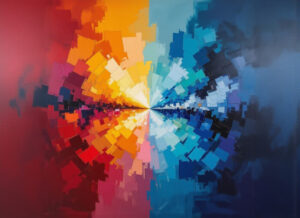After US’s bombing of nuclear facilities in Iran: Doubts on making the region safer. – Malte Göttsche assesses the situation.
By Josias Bruderer. The US interference in the war between Israel and Iran has hardly shed any light on the blurred situation, let alone made the region safer. Contradictory and divergent reports on the extent of the destruction, remaining facilities and consequences emphasize the lack of clarity. Malte Göttsche, a principal investigators of VeSPoTec and Professor for Peace Research in Natural Sciences at PRIF (Leibniz-Institut für Friedens- und Konfliktforschung), assesses the situation as follows:
We knew a lot before the attack because the inspectors from the International Atomic Energy Agency (IAEA) were in the country. Now we know nothing. Iran has become a kind of nuclear black box. (Malte Göttsche, interviewed by Isabel Reifenrath for hr-info, 00:18:00, translated from German)
Tehran suspended the cooperation with IAEA after the 12-day war between Israel and Iran, and US’s bombing of nuclear facilities in Iran. Still, the verification efforts (since 2004) suggest a different perspective regarding the insinuation of Iran’s will to build a nuclear bomb, neither are there any publicly available information that would say otherwise, Göttsche lays out for Frankfurter Rundschau. The past incident could turn out to be counterproductive:
That is my view and the predominant view of nuclear experts. At best, the bombing has set back Iran’s nuclear programme by some time. But in return, it has become more likely that Iran could make a decision in favour of the nuclear bomb. (Malte Göttsche, interviewed by Pitt von Bebenburg for Frankfurter Rundschau, translated from German)
Short-Term Gains, Long-Term Risks

Doubts on making the region safer are legit. The agreement with Iran about limitation and verification of its nuclear program was to be in effect for fifteen years. Despite this is criticized as a short time, it was something to build on, compared to the presumably few months that Iran’s nuclear program was set back now. Donald Trump’s (unilateral) termination of the nuclear agreement with Iran, along with the US bombing, call the political will (and potentials) to solve this conflict diplomatically into question. Additionally, Iran insists on its NPT right to peacefully use nuclear energy and criticizes the international focus on its program as unjustified. Despite these challenges, Göttsche states that returning to the negotiating table is the only viable option.
What happens after negotiations? – Most probably verification will need to continue – something that Rafael Grossi, Director General of the IAEA, emphasize as necessary as well (CBS News). In contrast, in recent statements Tehran characterized the IAEA as politically biased, utilising these perceptions as justification for suspending certain safeguards – even going so far as demanding reforms of the IAEA (Tehran Times).
Rethinking Verification: Challenges at the Crossroads of Politics and Technology
In the haze of these dangerous and tensions-loaded times, strengthened and advanced knowledge on verification in the context of peace and conflict research is crucial, and at the same time challenging. Drafts of broad questions that can be connected to these latest developments shall end this wrap-up and give a glimpse into possible future paths of Verification in a complex and unpredictable world: social, political and technical processes:
- Understanding of “verification”: In light of significant challenges of safeguard systems and new technologies, how to advance a new understanding of “verification” and how does this look like?
- Cognitive-strategic framing: Which role do strategic narratives, different worldviews and cognitive structures behind established verification regimes play? (Keywords: Disinformation and perceptual distortion)
- Local norms and interpretations: How can confidence-building be adapted to local norms and interpretations?
Referenced articles:
- Grossi, R. (2025, Juni 29). Transcript: Rafael Mariano Grossi, IAEA director general, on „Face the Nation with Margaret Brennan,“ June 29, 2025 – CBS News (M. Brennan) [CBS News]. https://www.cbsnews.com/news/transcript-rafael-mariano-grossi-international-atomic-energy-agency-face-the-nation-with-margaret-brennan-june-28-2025/
- IAEA’s double standards threaten regional and global peace, Pezeshkian tells Macron. (2025, Juni 30). Tehran Times. https://www.tehrantimes.com/news/515147/IAEA-s-double-standards-threaten-regional-and-global-peace-Pezeshkian
- Nach US-Luftschlägen: „Der Iran wird jetzt eine Blackbox“. (2025, Juli 1). Frankfurter Rundschau. https://www.fr.de/politik/welt-weiter-raetseln-die-folgen-der-luftschlaege-des-us-militaers-gegen-den-iran-lassen-die-93808491.html
- Reifenrath, I. (o. J.). Echt Bombe! Rückfall ins Atomzeitalter (No. 30.06.25) [Broadcast]. Abgerufen 3. Juli 2025, von https://www.hr-inforadio.de/podcast/der-tag/echt-bombe-rueckfall-ins-atomzeitalter,podcast-episode-142028.html
More:
- Funk, V. (2025, Juni 26). Iran: Was die US-Bomben bewirkt haben könnten. Table.Briefings.https://table.media/security/analyse/iran-was-die-us-bomben-bewirkt-haben-koennten (Paywall)
- Hal, G. van. (2025, Juni 19). Zes vragen over de Iraanse kernbom. Moest Israël aanvallen? de Volkskrant.https://www.volkskrant.nl/wetenschap/zes-vragen-over-de-iraanse-kernbom-moest-israel-aanvallen~bcdfc4bd/ (Paywall)
- Temmerman, M. (2025, Juni 19). “De moeilijkste stap is al gezet”: Hoe kan Israël weten dat Iran aan kernwapen bezig is? En hoever het daarmee staat? Nieuwsblad. https://www.nieuwsblad.be/buitenland/de-moeilijkste-stap-is-al-gezet-hoe-kan-israel-weten-dat-iran-aan-kernwapen-bezig-is-en-hoever-het-daarmee-staat/72781877.html (Paywall)
